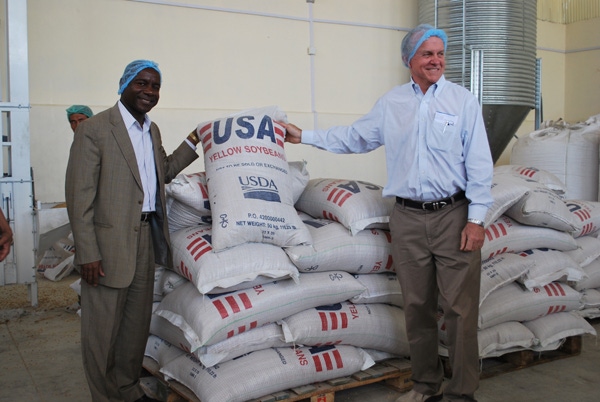September 12, 2012

Adistance of 7,000 miles is just the start of the differences between the Brookville, Ohio, farm where Steve Berk grew up raising soybeans as an FFA project and his current residence in Afghanistan. Yet, a new soybean processing factory creates a landmark link between states like Ohio and Afghan reconstruction efforts.
Berk is a USDA senior representative at the U.S. Consulate in Mazar-i-Sharif. He and U.S. Foreign Agricultural Service Agriculture Minister Counselor Quintin Gray joined the American Soybean Association’s (ASA) World Initiative for Soy in Human Health (WISHH) Program at the unique soy processing business this summer.
“It’s great to see the Afghan and U.S. partners get this soybean processing facility up and operating,” Gray says. “It will help Afghanistan agriculture continue to develop.”
Through USDA’s Food for Progress Program, WISHH and its partners have established Afghanistan’s first commercial soybean value chain as part of the Soybeans in Agricultural Renewal of Afghanistan Initiative (SARAI). As a result, Iowa-made processing equipment from Insta-Pro now has soybeans from Afghanistan as well as Ohio, Michigan and other states flowing through it. An Afghan company provided the land and the building as well as employs the staff.
People and livestock will benefit from the high-protein soy flour, soy meal and the crude soybean oil produced at the Mazar-e-Sharif manufacturing facility. An Afghan dairy, Kefayat Farms, made the first purchase of 10 metric tons of soybean meal for its herd of 140 Holstein cows. Farmhands soon noted the cows producing two to three additional liters of milk a day, and the milk quality was noticeably improved so customers were willing to pay more.
A solid supply of soybeans is key to the processing plant serving as a reliable source to its customers. Throughout the three-year project, more than 200,000 bu. of U.S. soybeans will augment local production processed in the plant. Perdue Grain and Oilseed’s 2011 sale exemplifies how U.S. soybeans contribute to the processing plant being a steady supplier of soy products in Afghanistan.
For example, USDA purchased 1,500 metric tons of soybeans for the processing plant’s use from Perdue’s partnership with Commercial Lynks, a Virginia-based trading company. Perdue has more than 70 grain elevators east of the Mississippi River and used Michigan and Ohio soybeans for the USDA purchase. The soybean sale further contributed to the U.S. economy as the shipment loaded at a port facility in Chesapeake, Va.
According to Perdue Grain and Oilseed Vice President John Cassidy, developing country markets represent a growing demand for U.S. feed ingredients. “WISHH is an important tool to expand markets in the U.S. soybean industry,” says Cassidy, who also appreciates the importance of USDA backing of the financing in countries that have immature banking sectors.
In 2011, the project also assisted 891 Afghan farmers, including 91 women, in producing the country’s first commercial crop of soybeans on a total of approximately 450 acres. This year, 3,325 Afghan farmers, including 300 women, are planting soybeans through SARAI.
The U.S. Department of State and Department of Defense contributed to this success by assisting ASA’s WISHH with military air transport of the Stine soybean seeds from Illinois to Bagram Airfield, Afghanistan. The shipment was then trucked to farmers in a northern province. In 2011-2012, a combined total of approximately 50 metric tons of U.S. soybean seeds went to Afghanistan for farmers to plant.
In addition to generating income for subsistence farmers who typically have less than an acre of land, the soybeans are priming the growth of oilseed demand in the country. Currently, Afghanistan imports more than 90% of its cooking oil. Much of that is palm oil. Afghanistan’s poultry and livestock industries also look to expand with quality meal from oilseed crops, such as soybeans.
You May Also Like




